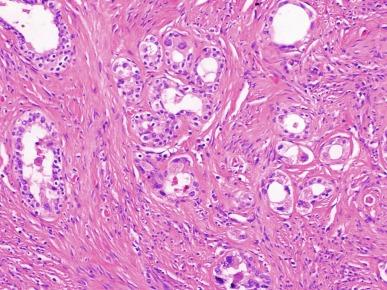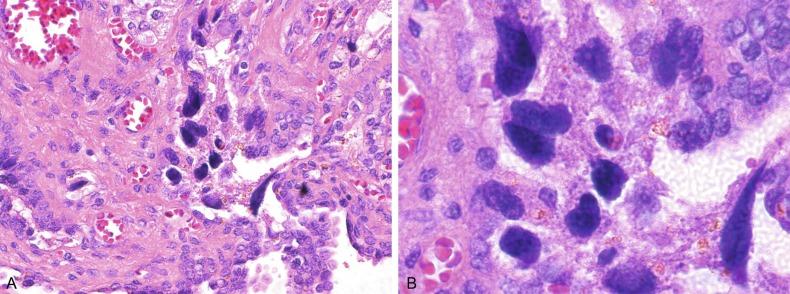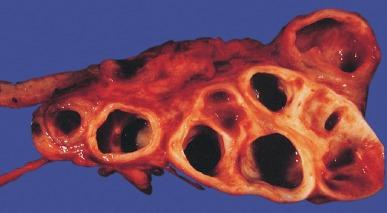Physical Address
304 North Cardinal St.
Dorchester Center, MA 02124
The seminal vesicles were described by the Italian anatomist Berengario a Carpi in 1521. These paired androgen-dependent accessory sex glands were first regarded simply as storage sites for semen, but their milky alkaline secretions are now known to constitute the majority of the ejaculate, promoting sperm function and providing a variety of potent antibacterial factors to the male genital tract. Cross-sectional area increases with duration of abstinence from ejaculation. Infections, cysts, and neoplasms of the seminal vesicles are rare, in sharp contrast with their anatomic neighbor, the prostate.
Under the influence of testosterone, the seminal vesicles appear during the thirteenth week of development as outpouchings of the lower mesonephric ducts. They are bounded by the prostate distally, the base of the bladder anteriorly, and Denonvilliers fascia and the rectum posteriorly. Their anatomic position in this region is variable, and they are sometimes found within or adherent to the posterior capsule of the prostate gland. The seminal vesicles may be palpable on digital rectal examination and, when adherent to the prostate, may be mistaken for prostatic nodularity or induration. Approximately 5% of prostate biopsies for nodularity contain fragments of seminal vesicle epithelium, a potential source of diagnostic confusion ( Fig. 10.1 ). In adults the seminal vesicles average 6 cm long and 2 cm wide, with a capacity of up to 4.5 mL, although there is wide variation in size, shape, and volume. Interestingly, α blockers, such as silodosin, tamsulosin, and alfuzosin used for treating prostatic nodular hyperplasia, create loss of seminal emission and seminal vesicular enlargement.

The muscular wall of the seminal vesicles consists of a thick circumferential coat of smooth muscle, which contracts during ejaculation. Contraction is regulated by excitatory adrenergic and modulatory neuropeptide Y-encephalin-peptidergic nerve fibers. Tangential cuts through this wall frequently reveal irregular clusters of epithelial tubules, which may be mistaken for adenocarcinoma.
The ducts of the seminal vesicles merge with the ampullae of the vasa deferentia on each side to form the ejaculatory ducts, and these structures compose a functional unit that develops slowly until the onset of puberty. These ducts immediately enter the central zone of the prostate and converge as they approach their outlets at either side of the verumontanum in the prostatic sinus of the prostatic urethra. Unlike the seminal vesicles, the ejaculatory ducts lack a thick muscular wall, surrounded by a collagenous stroma. Luminal and wall dimensions are remarkably uniform among adult men, with diameter greater than 2.3 mm the cutpoint for dilatation.
Histologically the seminal vesicular mucosa consists of complex papillary folds and irregular convoluted lumens lined with nonciliated, pseudostratified tall columnar epithelium. The cells are predominantly secretory, containing microvesicular lipid droplets and characteristic lipofuscin pigment granules. The pigment is golden-brown and refractile, increasing in amount with age; similar pigment may be seen in prostatic epithelium, but is usually less conspicuous and abundant. These cells also contain androgen receptors, similar to the prostatic epithelium. Secretory products include glycoproteins, protein kinase inhibitor, protein C inhibitor, fructose, prostaglandins, ascorbic acid, sperm motility factor, transferrin, lactoferrin, lysozyme, and metallothionein. Secretion is regulated by nerves from the pelvic plexus, which are cholinergic postganglionic, sympathetic, and possibly parasympathetic. Nerves are arranged in a vertical plate lateral to the seminal vesicles. Mean ± SD distance of nerves to the seminal vesicles was 1.68 ± 0.84, 1.50 ± 0.12, and 1.76 ± 0.37 mm at the tip, middle, and base, respectively. Up to 85% of the seminal fluid originates in the seminal vesicles, and the semen volume varies from 2 to 5 mL. It takes 3 days for the epithelium to refill the seminal vesicles after ejaculation.
MUC6 is selectively expressed in benign seminal vesicle epithelium, in contrast with benign prostate and adenocarcinoma. Likewise, intense immunohistochemical expression of GATA binding protein 3 (GATA3) in seminal vesicle epithelium may help distinguish from mimics, although this marker is also positive in prostatic basal cells and, with less intensity, in secretory cells, and rarely in prostatic adenocarcinoma.
The seminal vesicles begin to shrink in the seventh decade. The tall columnar cells lining the mucosa in young men are replaced over time by flattened cuboidal cells, comprising only 50% of the epithelium in men in the fifth decade of life and 2% in octogenarians. With advancing age, the stroma of the seminal vesicles becomes hyalinized and fibrotic. In sexually active middle-aged men, the volume of the seminal vesicles was significantly larger in those who had a sexual frequency once every 3 months than in those who had a sexual frequency once every 6 months or less.
The flattening of the epithelium is accompanied by striking nuclear abnormalities, and highly atypical cells are present in about 75% of older men ( Fig. 10.2 ). These cells have large irregular hyperchromatic nuclei with coarse chromatin and prominent nucleoli. Multinucleated cells are also present, as well as giant ring-shaped nuclei with large intranuclear cytoplasmic inclusions. Mitotic figures are absent. These nuclear abnormalities, not observed before age 20 years, are probably degenerative changes reflecting hormonal influences. When encountered in needle biopsies, such “pseudomalignant” cytologic atypia may lead to a mistaken diagnosis of prostate cancer. Difficulty may also be encountered in cytologic evaluation of fluids obtained by prostatic massage because seminal vesicular cells are frequently shed intact into the lumens. The distinctive lipochrome pigment aids in their recognition. Cells in prostatic aspirates derived from the seminal vesicles and ejaculatory ducts may be cytologically indistinguishable. DNA ploidy analysis reveals aneuploidy in up to 48% of seminal vesicles. Consequently DNA analysis of prostate cancer specimens may yield false-positive results if contaminated by seminal vesicle tissue. It is uncertain why there is such a low level of aneuploidy in an organ with frequent and substantial cytologic atypia.

Seminal vesicular cells are found as contaminants of cervical smears in 10% of specimens with spermatozoa, and they may be diagnostically confusing. These cells contain foamy cytoplasm, scant pigment, vesicular hyperchromatic nuclei, sievelike chromatin pattern, and mild anisokaryosis.
Malformations of the seminal vesicles are frequently associated with abnormal development of other mesonephric derivatives, although isolated hypoplasia, agenesis, and cysts have been reported. Unilateral absence of one seminal vesicle may be associated with ipsilateral prostatic central zone agenesis, renal agenesis, or vas deferens anomalies or agenesis. Unilateral agenesis is often associated with decreased semen volume, hypospermia or azoospermia, impaired sperm motility, acidic ejaculate, and absence of fructose and coagulation activity. Up to 37.5% of these men are infertile, implying that the single vas is abnormal. Bilateral dilation or absence of the seminal vesicles is sometimes observed in patients with cystic fibrosis, reportedly caused by an unexplained failure of development. Unilateral duplication of the seminal vesicles is an unusual anomaly. Seminal vesicle surgery is usually undertaken for evaluation of congenital malformations.
Maldevelopment of the ureteric bud results in ureteral ectopy, with the ureters terminating in the seminal vesicles, prostatic urethra, vas deferens, epididymis, or ejaculatory ducts. Ureteral ectopy is frequently seen in association with ipsilateral renal dysgenesis or contralateral renal hypertrophy, and the seminal vesicles become enlarged and dilated with accompanying ureterocele.
Seminal vesicle cysts are rare and may be congenital or acquired. Symptoms are vague, including perineal pain during ejaculation or defecation, dysuria, urinary retention, and recurrent epididymitis. Congenital cysts are associated with ipsilateral renal agenesis in 80% of cases and commonly with ureteral ectopia or agenesis (Zinner syndrome), with more than 100 reported cases. These paired anomalies are caused by the close association of the ureteric bud and mesonephric duct during embryogenesis; the ureteric bud is more cephalad, and the elongated ureter may fail to connect with and stimulate the differentiation of the nephrogenic blastema. Hajji et al. described a unique variant of inverted Y ureteral duplication with concurrent ectopic ureteral insertion into a seminal vesicle cyst, ureterocele, and renal dysgenesis in a 29-year-old man with lower urinary tract symptoms, hematospermia, and postcoital discomfort. Other cases of congenital cysts are associated with ipsilateral absence of the testis or hemivertebra. Congenital cysts of the seminal vesicle are usually detected in patients between 18 and 41 years of age, the period of maximal sexual and reproductive activity; most have arisen in Caucasian patients. Cysts may be asymptomatic or cause ill-defined lower urinary tract symptoms. Magnetic resonance imaging (MRI) is useful for detecting cysts and associated urogenital tract anomalies. Interestingly, 23% of men with adult polycystic kidney disease have seminal vesicle ectasia (cystic changes).
The cyst is usually unilateral and unilocular, lateral to the midline, up to three times larger than the normal seminal vesicle, and considerably smaller than müllerian duct cyst ( Table 10.1 ), although rarely the cyst is gigantic and may cause rectal obstruction. Enlargement is caused by insufficient drainage with accumulation of seminal fluid. The unilocular cyst contains viscous pale-white fluid, similar to the usual secretions of the seminal vesicles, and is lined by cuboidal or flattened epithelium with a fibrous wall of variable thickness. Rarely there may be intracystic papillary adenoma. Massive enlargement has been called hydrocele or hydrops. Bilateral congenital cysts are rare and may be associated with absent vasa deferentia.
| Type of Cyst | Location | Size | Contains Spermatozoa |
|---|---|---|---|
| Seminal vesicle cyst | Lateral | Large | Yes |
| Diverticulum of ejaculatory duct | Lateral | Variable | Yes |
| Prostatic cyst | Lateral | Variable | No |
| Müllerian duct cyst | Midline | Large | No |
Acquired cyst is usually associated with inflammation and obstruction of the ejaculatory ducts and seminal vesicles ( Fig. 10.3 ). This fluctuant cyst may be palpable on digital rectal examination and often contains red cells, white cells, and spermatozoa. The epithelial lining is inflamed or sloughed, depending on the duration and severity of inflammation. In one case, endoscopic removal of a small calculus lodged at the orifice of the ipsilateral ejaculatory duct caused complete resolution of a 14-cm seminal vesicle cyst, evidence for an obstructive etiology and demonstration of the utility of preoperative imaging techniques to detect stones. One unique case presented as an inguinal hernia, with the cyst extending through the inguinal canal.

Echinococcal (hydatid) cyst can occur in the retrovesicular region, invariably in association with infection in another organ; cyst excision is curative. Megavesicles are characterized by marked dilation of the seminal vesicles. The cause of megavesicles is unknown, but this condition is sometimes seen in individuals with diabetes. Cystadenoma is a benign neoplasm mimicking acquired cyst (see later).
The differential diagnosis of seminal vesicle cyst includes prostatic cyst, ejaculatory duct diverticulum, and cystic dilation of wolffian and müllerian duct remnants ( Table 10.1 ). The cyst may produce hydronephrosis caused by displacement of the lower ureter toward the midline with obstruction. Radiographic evaluation of seminal vesicle cyst includes vasoseminovesiculography, ultrasonography, computerized tomography (CT), and MRI. Aspiration of congenital or acquired cysts relieves symptoms, but surgical removal or marsupialization is preferred.
Become a Clinical Tree membership for Full access and enjoy Unlimited articles
If you are a member. Log in here